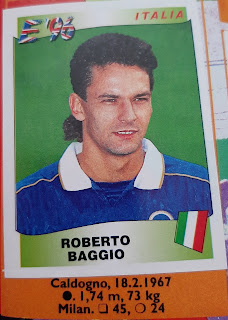157: Tomas Brolin, Sverige, USA ’94 World Cup, UK and Eire Edition
If
you were a lower to mid-table Premiership club in the 1990s it was almost rude
not to sign at least one experienced international player ahead of the new
season. Ideally this player would have at least 20 caps for their country and
have performed well at a major international tournament. If you were really
lucky they would have also won a handful of trophies abroad and possibly even
have had some success in continental club football and, for the record, the Cup
Winners’ Cup definitely counts.
When
Leeds United signed Swedish playmaker Tomas Brolin in November 1995 they signed
a player who ticked all of the above boxes. He had been the joint top-scorer at
Euro ’92 with three goals, including one against England set to some excellent
Barry Davies commentary, and had repeated the feat in the 1994 World Cup in the
USA where Sweden defied expectation to finish third in the tournament. At club
level he had been a key part of a Parma side that had won both the UEFA Cup and
Cup Winners’ Cup as well as going toe-to-toe with Serie A giants Juventus and
AC Milan during the league’s golden era. Leeds got all of this for a mere £4.5m.
What could possibly go wrong?
As
I’m sure any Leeds, or Palace, fan will tell you: quite a lot. Brolin made a
decent start for Leeds but had fallen out with United boss Howard Wilkinson by
January 1996 following a 5-0 defeat to Liverpool. Years after the event Brolin
admitted he had put in a poor performance in part as a protest against
Wilkinson playing him out of position on the right wing. He further damaged the
relationship with his manager with an April Fool’s prank where he announced he
would be returning to his boyhood club, IFK Norrkoping, on loan for the remainder
of the season. Subsequent actual loan spells at Zurich and Parma had the
desired impact of improving Brolin’s fitness but failed to manifest in a move
away from Leeds and the Swede’s relationship with new manager, George Graham,
continued to sour as he missed training sessions and reserve matches throughout
1997. His contract was terminated in October of the same year.
As
the club endured one of its most miserable seasons, in at least my living
memory, Crystal Palace stepped in and signed Brolin on trial in January 1998.
He played mainly as a striker, due to a combination of injuries and the bizarre
decision to sell Dougie Freedman and George Ndah in the early stages of the
season, but failed to score in his sixteen games for the club. He made his last
appearance in a 3-0 home defeat to Manchester United which confirmed the club’s
relegation and was released in the summer. By this stage Brolin was overweight,
out of form and out of options to prolong his career. After playing one last
game for Swedish second divison side Hudviksvall, in goal of all positions, he
retired from football at the age of 28 in August 1998.
Brolin
has mainly been remembered, at least in England, for the catastrophic end to
his footballing career and suffered the indignity of being named as Leeds’
worst ever signing in 2003 where he was described as “arriving with an enormous
reputation and leaving with an ever bigger gut.” Whether this a fair summary of
his overall career is questionable. In the first half of the 1990s Brolin was
undoubtedly one of the best players on the planet and a key part of a Parma
side which bloodied some significant noses in Italy and across Europe. His 27
goals in 47 appearances for Sweden cannot be sniffed at and his performances in
Euro ’92 and the 1994 World Cup were truly excellent.
Leeds
and Palace fans might not recognise the fresh faced 24 year old in the image
above but perhaps it’s time to remember Tomas Brolin in his prime, representing
his country in a World Cup where he would be named in the team of the
tournament…even if he was bloody useless at Selhurst Park.





Comments
Post a Comment